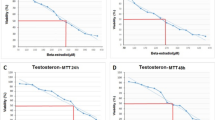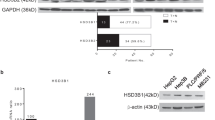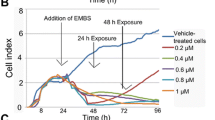Abstract
Purpose
2-Methoxyestradiol (2-ME) is a physiological metabolite of estrogen, which can inhibit growth of many types of tumor cells, including hepatocellular carcinoma, both in vitro and in vivo. The exact mechanisms of its action are still unclear. We have studied the mechanisms of growth inhibition of several of human and rat hepatoma and normal liver cells by 2-ME.
Methods
Human (Hep3B, HepG2, PLC/PRF5) and rat (McA-RH7777, JM-1) hepatoma and normal rat (CRL-1439) and human (CRL-11233) liver cell lines were cultured in vitro, in presence of 2-ME, and its IC50s were determined. Cell cycle arrest, Cdc25 phosphatase inhibition and apoptosis induction were studied. Finally, the effect of 2-ME on the growth of JM-1 rat hepatoma cells in rat liver was determined in vivo.
Results
The IC50 range for growth inhibition of hepatoma cells was found to be between 0.5 and 3 μM. In contrast, normal rat hepatocytes and liver cell lines were resistant to 2-ME up to 20 μM. JM-1 cells were arrested in the G2/M phase of the cell cycle. Cdc25A and Cdc25B, cell cycle controlling phosphatases, activities were inhibited in vitro and 2-ME was found to likely bind to their catalytic site cysteines. As a consequence, their cellular substrates Cdk1 and Cdk2 were tyrosine phosphorylated. Caspase-3 was cleaved suggesting apoptotic cell death. Moreover, growth of JM-1 tumors, which were transplanted into rat liver, was also inhibited by treatment with 2-ME in vivo.
Conclusions
2-Methoxyestradiol is a selective, potent and relatively non-toxic hepatoma growth inhibitor both in vitro and in vivo. Cell cycle arrest of hepatoma cells was likely mediated by binding and inactivation of the Cdc25 phosphatases and induction of apoptosis.








Similar content being viewed by others
Abbreviations
- HCC:
-
Hepatocellular carcinoma
- WB:
-
Western blot
- EGF:
-
Epidermal growth factor
- 2-ME:
-
2-Methoxyestradiol
References
Fiegelson HS, Henderson BE (1996) Estrogens and breast cancer (review). Carcinogenesis 17:2279–2284
McDonald TW, Annegers JF, O’Fallon WM, Dockerty MB, Malkasian GD Jr, Kurland LT (1977) Exogenous estrogen and endometrial carcinoma: case-control and incidence study. Am J Obstet Gynecol 127:572–580
Pritchard KI (2000) Current and future directions in medical therapy for breast carcinoma: endocrine treatment. Cancer 88(Suppl 12):3065–3072
Seegers JC, Aveling ML, Van Aswegen CH, Cross M, Koch F, Joubert WS (1989) The cytotoxic effects of estradiol-17-beta, catecholestradiol and methoxyestradiol on dividing MCF-7 and HeLa cells. J Steroid Biochem 32:797–809
Berg D, Sonsalla R, Kuss E (1983) Concentrations of 2-methoxyestrogens in human serum measured by a heterogenous immunoassay with an 125I-labelled ligand. Acta Endrocinol (Copenh) 103:1375–1378
Klauber N, Parangi S, Flynn E, Hammel E, D’Amato RJ (1997) Inhibition of angiogenesis and breast cancer in mice by the microtubule inhibitors 2-methoxyestradiol and taxol. Cancer Res 57:81–86
Kataoka M, Schumacher G, Cristiano RJ, Atkinson EN, Roth JA, Mukhopadhyay T (1998) An agent that increases tumor suppressor transgene product coupled with systemic transgene delivery inhibits growth of metastatic lung cancer in vivo. Cancer Res 58:4761–4765
Schumacher G, Kataoka M, Roth JA, Mukhopadhyay T (1999) Potent antitumor activity of 2-methoxyestradiol in human pancreatic cancer cell lines. Clin Cancer Res 5:493–499
Wassberg E (1999) Angiostatic treatment of neuroblastoma. Ups J Med Sci 104:1–24
Lin HL, Liu TY, Chau GY, Lui WY, Chi CW (2000) Comparison of 2-methoxyestradiol-induced, docetaxel-induced, and paclitaxel-induced apoptosis in hepatoma cells and its correlation with reactive oxygen species. Cancer 89:983–994
Bu S, Blaukat A, Fu X, Heldin NE, Landstrom M (2002) Mechanisms for 2-methoxyestradiol-induced apoptosis of prostate cancer cells. FEBS Lett 531:141–151
LaValle TM, Zhan XH, Herbstritt CJ, Kough KC, Green SJ, Pribluda VS (2002) 2-Methoxyestradiol inhibits proliferation and induces apoptosis independently of estrogen receptors a and b. Cancer Res 62:3691–3697
Fostis T, Zhang Y, Pepper MS, Alder cruetz H, Montesano R, Nawroth PP, Schweigerer L (1994) The endogenous estrogen metabolite 2-methoxyestradiol inhibits angiogenesis and suppress tumor growth. Nature 368:237–239
Cushman M, He HM, Katzenellenbogen JA, Lin CM, Hamel E (1995) Synthesis, antitubulin and antimitotic activity, and cytotoxicity of analogs of 2-methoxyestradiol, an endogenous mammalian metabolite of estradiol that inhibits tubulin polymerization by binding to the colchicines binding site. J Med Chem 38:2041–2049
Attalla H, Makels TP, Adelkreutz H, Anderson LC (1996) 2-Methoxyestradiol arrests cells in mitosis without depolymerizing tubulin. Biochem Biophys Res Comm 228:467–473
Gao N, Rahmani M, Dent P, Grant S (2005) 2-Methoxyestradiol-induced apoptosis in human leukemia cells proceeds through a reactive oxygen apecies and Akt-dependent process. Oncogene 14:3797–3809
McCormick DL, Johmson WD, Peibluda VS, Green SJ, Tomaszewski JE, Smith AC (2000) Preclinical development of 2-methoxyestradiol (2ME2, NSC-659853) (abstract). Proc Am Assoc Cancer Res 41(2080):328
Schumacher G, Scheunert S, Rueggeberg A, Bachem MG, Nussler AK, Spinelli A, Mukhopadhyay T, Pratchke J, Neuhaus P (2006) A very low toxic agent induces apoptosis and reduces growth of human hepatocellular carcinoma cells. Hepatology 21:1207–1212
Nilsson I, Hoffman I (2000) Cell cycle regulation by the Cdc25 phosphatase family. Prog Cell Cycle Res 4:107–144
Jinno S, Suto J, Nagata A, Igarashi M, Kanaoka Y, Nojima H, Okayama H (1994) Cdc25A is a novel phosphatase functioning early in the cell cycle. EMBO J 13:1549–1556
Forrest AR, McCormack AK, DeSouza CP, Sinnamon JM, Tonks ID, Haywrd NK, Ellem K, Gabrielli BG (1999) Multiple splicing variants of cdc25B regulate G2/M progression. Biochem Biophys Res Commun 260:510–515
Donazelli M, Draetta GF (2003) Regulating mammalian checkpoints through Cdc25 inactivation. EMBO J 4:671–677
Molinari M, Mercurilo C, Dominguez J, Goubin F, Draetta GF (2000) Human Cdca5A inactivation in response to S phase inhibition and its role in preventing premature mitosis. EMBO J 1:71–79
Mailand N, Falck J, Lukas C, Syljuasen RG, Welcker M, Lukas J (2000) Rapid destruction of human Cdc25A in response to DNA damage. Science 288:1425–1429
Santamaria D, Barriere C, Cerqueira A, Hunt S, Tardy c, Newton K, Caceres JF, Dubus P, Malumbres M, Barbacid M (2007) Cdk1 is sufficient to drive the mammalian cell cycle. Nature 448:811–816
Parsons AR (1998) Phosphatases and tumorigenesis. Curr Opin Oncol 10:88–91
Kristjansdottir K, Rudolph J (2004) Cdc25 phosphatases and cancer. Chem Biol 11:1043–1051
Gasparotto D, Maestro R, Piccinin S, Vukosavljevic T, Barzan L, Sulfaro S, Boiocchi M (1997) Overexpression of Cdc25A and Cdc25B in head and neck cancers. Cancer Res 57:2366–236
Hernandez S, Besser X, Bea S et al (2001) Differential expression of Cdc25 cell-cycle activating phosphatases in human colorectal carcinoma. Lab Invest 81:465–470
Carr BI, Wang Z, Wang M, Kar S, Wilcox CS, Rosi K, Southwick E, Lazo JS (2003) A Cdc25A antagonizing K vitamin inhibits hepatocyte DNA synthesis in vitro and in vivo. J Mol Biol 326:721–735
Kar S, Wang M, Ham SW, Carr BI (2006) H32, a non-quinone sulfone analog of vitamin K3, inhibits human hepatoma cell growth by inhibiting Cdc25 and activating ERK. Cancer Biol Ther 5:1340–1347
Nishikawa Y, Carr BI, Wang Z, Kar S, Finn F, Dowd P, Zheng ZB, Kerns J, Naganathan SJ (1995) Growth inhibition of hepatoma cells induced by vitamin K and its analogs. J Biol Chem 270:28304–28310
Kar S, Carr BI (2000) Growth inhibition and protein tyrosine phosphorylation in MCF7 breast cancer cells by a novel K-vitamin. J Cell Physiol 185:386–393
Tamura K, Southwick EC, Kerns J, Rosi K, Carr BI, Wilcox C, Lazo J (2000) Cdc25 inhibition and cell cycle arrest by a synthetic thioalkyl vitamin K analogue. Cancer Res 60:1317–1325
Novicki DL, Jirtle RL, Michalopoulos G (1983) Establishment of two rat hepatoma cell strains produced by a carcinogen initiation, phenobarbital promotion protocol. In Vitro 19:191–202
D’Amato RJ, Lin CM, Flynn E, Folkman J, Hamel E (1994) 2-Methoxyestradiol, an endogenous mammalian metabolite, inhibits tubulin polymerization by interacting at the colchicine site. Proc Natl Acad Sci USA 91:3964–3968
Kar S, Lefterov IM, Wang M, Lazo JS, Scott CN, Wilcox CS, Carr BI (2003) Binding and Inhibition of Cdc25 phosphatases by vitamin K analogues. Biochemistry 42:10490–10497
Kar S, Wang M, Ham SW, Carr BI (2006) Fluorinated Cpd 5, a pure arylating K-vitamin derivative, inhibits human hepatoma cell growth by inhibiting Cdc25 and activating MAPK. Biochem Pharmacol 72:1217–1227
Huber JB et al (2000) Oral administration of an estrogen metabolite-induced potentiation of radiation anti-tumor effects in presence of wild type p53 in non small cell lung cancer. Int J Radiat Oncol Biol Phys 48:1127–1137
Sweeney C et al (2005) A phase II multicenter, randomised, double-blind, safety trial assessing the pharmacokinetics, pharmacodynamics, and efficacy of oral 2-methoxyestradiol capsules in hormone-refractory prostate cancer. Clin Cancer Res 11:6625–6633
Dahut WL et al (2006) Phase I clinical trial of oral 2-methoxyestradiol, an antiangiogenic and apoptotic agent, in patients with solid tumors. Cancer Biol Ther 5:22–27
Lakhani NJ et al (2005) Determination of 2-methoxyestradiol in human plasma, using liquid chromatography/tandem mass spectrometry. Rapid Commun Mass Spectrom 19:1176–1182
Ireson CR et al (2004) Pharmacokinetics and efficacy of 2-methoxyoestradiol and 2-methoxyoestradiol-bis-sulphamate in vivo in rodents. Br J Cancer 90:932–937
Chen RA, Michaeli T, Van Aelst L, Ballester R (2000) A role of the noncatalytic N terminus in the function of Cdc25, a Saccharomyces cerevisiae Ras-Guanine nucleotide exchange factor. Genetics 154:1473–1484
Fernandes-Alnemri T et al (1994) CPP32, a novel human apoptotic protein with homology to Caenorhabditis elegans cell death protein Ced-3 and mammalian interleukin-1 beta-converting enzyme.J Biol Chem 269:30761–30764
Nicholson DW, Thornberry NA, Vaillancourt JP, Ding CK et al (1995) Identification and inhibition of the ICE/CED-3 protease necessary for mammalian apoptosis. Nature 376:37–43
Kar S, Wang M, Wilcox CS, Carr BI (2003) Antitumor and anticarcinogenic action of Cpd 5: a new class of protein phosphatase inhibitor. Carcinogenesis 24:411–416
Author information
Authors and Affiliations
Corresponding author
Additional information
This work was supported in part by National Institutes of Health Grant CA 82723 (to B.I.C.).
Rights and permissions
About this article
Cite this article
Kar, S., Wang, M. & Carr, B.I. 2-Methoxyestradiol inhibits hepatocellular carcinoma cell growth by inhibiting Cdc25 and inducing cell cycle arrest and apoptosis. Cancer Chemother Pharmacol 62, 831–840 (2008). https://doi.org/10.1007/s00280-007-0670-x
Received:
Accepted:
Published:
Issue Date:
DOI: https://doi.org/10.1007/s00280-007-0670-x




